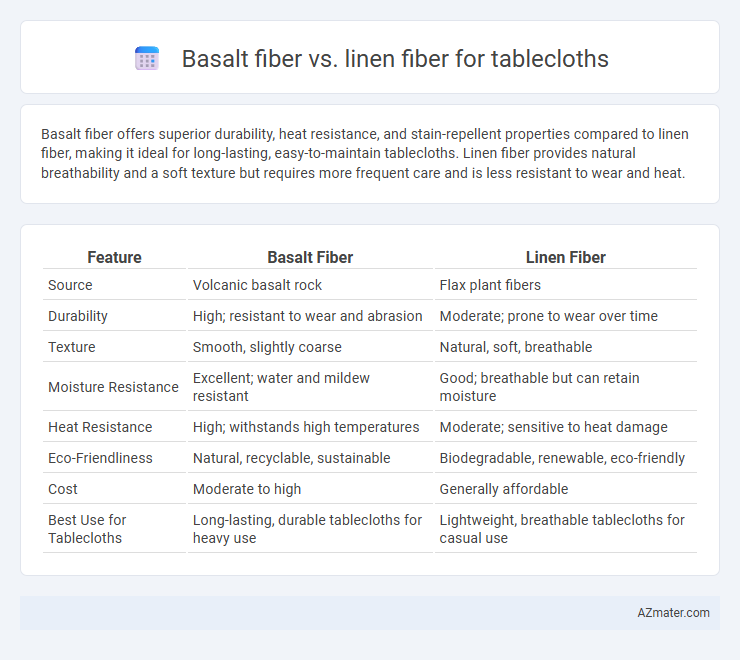Basalt fiber offers superior durability, heat resistance, and stain-repellent properties compared to linen fiber, making it ideal for long-lasting, easy-to-maintain tablecloths. Linen fiber provides natural breathability and a soft texture but requires more frequent care and is less resistant to wear and heat.
Table of Comparison
| Feature | Basalt Fiber | Linen Fiber |
|---|---|---|
| Source | Volcanic basalt rock | Flax plant fibers |
| Durability | High; resistant to wear and abrasion | Moderate; prone to wear over time |
| Texture | Smooth, slightly coarse | Natural, soft, breathable |
| Moisture Resistance | Excellent; water and mildew resistant | Good; breathable but can retain moisture |
| Heat Resistance | High; withstands high temperatures | Moderate; sensitive to heat damage |
| Eco-Friendliness | Natural, recyclable, sustainable | Biodegradable, renewable, eco-friendly |
| Cost | Moderate to high | Generally affordable |
| Best Use for Tablecloths | Long-lasting, durable tablecloths for heavy use | Lightweight, breathable tablecloths for casual use |
Introduction to Basalt Fiber and Linen Fiber
Basalt fiber, derived from volcanic basalt rock, offers exceptional strength, durability, and resistance to heat and chemicals, making it an innovative material for tablecloths that require long-lasting performance. Linen fiber, obtained from the flax plant, is cherished for its natural breathability, softness, and elegant texture, providing a classic and eco-friendly option for table linens. Comparing basalt fiber and linen fiber reveals distinct advantages: basalt excels in durability and maintenance, while linen emphasizes comfort and aesthetic appeal.
Composition and Source of Basalt and Linen Fibers
Basalt fiber is derived from molten basalt rock, primarily sourced from volcanic regions, known for its high tensile strength and resistance to heat and chemicals. Linen fiber originates from the flax plant, cultivated mainly in temperate climates, and is prized for its natural breathability and moisture-wicking properties. The inorganic mineral composition of basalt contrasts with the organic cellulose-rich structure of linen, influencing their durability and texture in tablecloth applications.
Mechanical Strength Comparison
Basalt fiber exhibits significantly higher tensile strength, typically ranging from 2.8 to 4.8 GPa, compared to linen fiber's tensile strength of approximately 0.3 to 0.6 GPa, making basalt fiber more resistant to stretching and deformation under load. The modulus of elasticity for basalt fiber is around 85-110 GPa, which surpasses linen fiber's modulus of 30-60 GPa, indicating better stiffness and durability for tablecloth applications. Basalt fiber also offers superior abrasion resistance and impact strength, ensuring longer-lasting mechanical performance in tablecloths exposed to everyday use.
Durability and Longevity
Basalt fiber exhibits superior durability for tablecloths due to its high tensile strength, resistance to abrasion, and excellent thermal stability, making it ideal for frequent use and exposure to heat. Linen fiber provides moderate durability with natural elasticity and breathability but tends to wear out faster under heavy use and repeated laundering. For long-lasting tablecloths, basalt fiber significantly outperforms linen by maintaining structural integrity and appearance over extended periods.
Aesthetics and Texture Differences
Basalt fiber tablecloths offer a smooth, lustrous finish with a subtle sheen, creating a modern and sophisticated aesthetic compared to linen's naturally matte and slightly coarse texture. Linen fiber provides a soft, breathable fabric with visible slubs and a rustic charm that enhances casual and traditional decor. The tactile difference lies in basalt's silky, resilient feel versus linen's more textured, organic touch, influencing both visual appeal and user experience.
Environmental Impact & Sustainability
Basalt fiber tablecloths offer superior environmental benefits due to their production from abundant volcanic rock, requiring less water and energy compared to linen fiber, which is derived from flax plants needing extensive agricultural inputs. Basalt fibers are fully recyclable and biodegradable, reducing landfill waste, while linen cultivation involves pesticide use and soil depletion concerns. Choosing basalt fiber supports sustainable textile manufacturing with a significantly lower carbon footprint and reduced chemical dependency.
Cost and Availability
Basalt fiber offers higher durability and heat resistance but comes at a significantly higher cost compared to linen fiber, making it less accessible for budget-conscious buyers. Linen fiber is widely available and more affordable due to its natural production and established supply chains, offering a cost-effective option for tablecloths. The availability of basalt fiber remains limited in many markets, whereas linen is commonly found in diverse textile outlets worldwide.
Thermal and Flame Resistance
Basalt fiber exhibits superior thermal stability withstanding temperatures up to 1,000degC, making it highly flame-resistant and ideal for tablecloths exposed to heat sources. Linen fiber, derived from flax, offers moderate thermal resistance but is more flammable and less durable under high heat conditions. Choosing basalt fiber ensures enhanced safety and longevity in environments requiring robust flame retardant properties for table linens.
Maintenance and Care Requirements
Basalt fiber tablecloths offer superior durability and stain resistance, requiring minimal maintenance compared to linen fiber, which often demands gentle washing and careful ironing to maintain its texture. Basalt fiber resists moisture and mildew, allowing for easy cleaning with mild soap and water, while linen fibers are prone to wrinkling and may need frequent professional care to retain their natural luster. The long-lasting nature of basalt fiber reduces replacement frequency, making it a more cost-effective choice for tablecloths in high-use environments.
Best Applications: Which Tablecloth to Choose?
Basalt fiber tablecloths offer exceptional durability and heat resistance, making them ideal for high-traffic dining areas and outdoor use. Linen fiber tablecloths excel in breathability and natural elegance, suitable for formal dining and special occasions where a soft, classic texture is preferred. Choosing between basalt and linen depends on the specific needs: basalt for robust, long-lasting performance, linen for aesthetic appeal and comfort.

Infographic: Basalt fiber vs Linen fiber for Tablecloth
 azmater.com
azmater.com